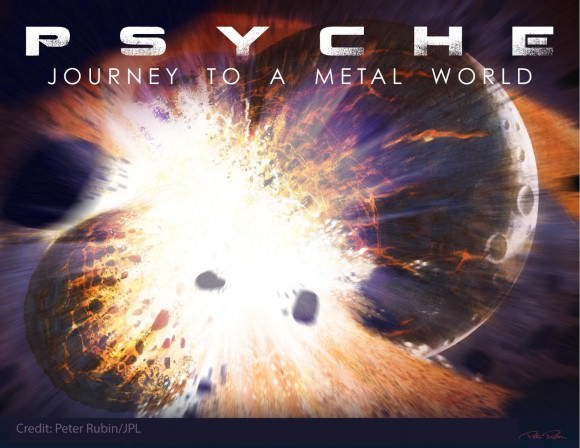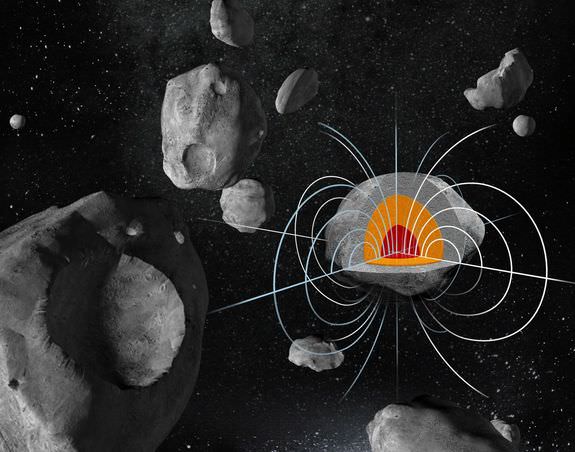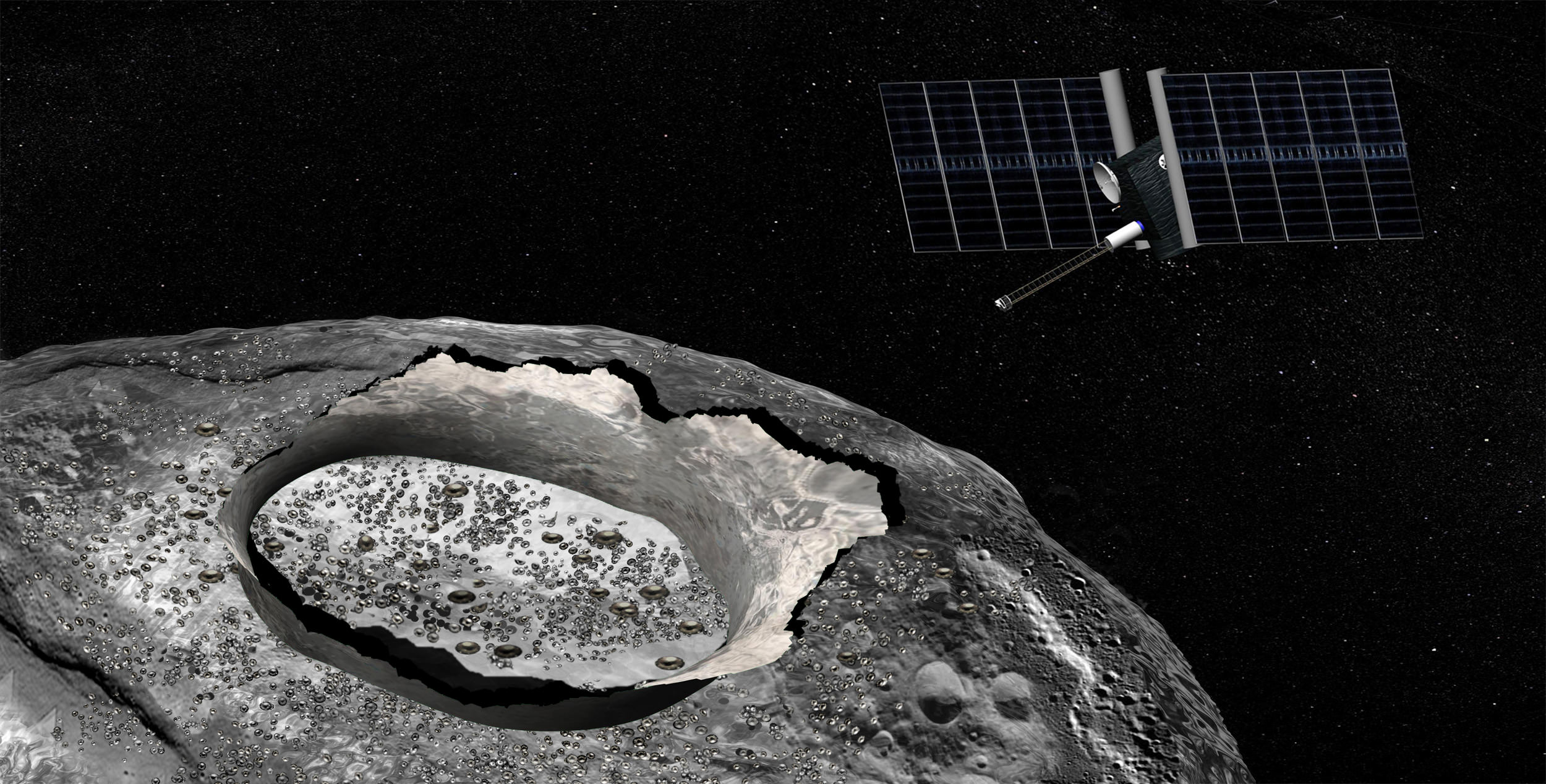In their drive to set exploration goals for the future, NASA’s Discovery Program put out the call for proposals for their thirteenth Discovery mission in February 2014. After reviewing the 27 initial proposals, a panel of NASA and other scientists and engineers recently selected five semifinalists for additional research and development, one or two of which will be launching by the 2020s.
With an eye to Venus, near-Earth objects and asteroids, these missions are looking beyond Mars to address other questions about the history and formation of our Solar System. Among them is the proposed Psyche mission, a robotic spacecraft that will explore the metallic asteroid of the same name – 16 Psyche – in the hopes of shedding some light on the mysteries of planet formation.
Discovered by Italian astronomer Annibale de Gasparis on March 17th, 1852 – and named after a Greek mythological figure – Psyche is one the ten most-massive asteroids in the Asteroid Belt. It is also the most massive M-type asteroid, a special class pertaining to asteroids composed primarily of nickel and iron.
For some time, scientists have speculated that this metallic asteroid is in fact the survivor of a protoplanet. In this scenario, a violent collision with a planetesimal stripped off Psyche’s outer, rocky layers, leaving behind only the dense, metallic interior. This theory is supported by estimates of Psyche’s bulk density, spectra, and radar surface properties; all of which show it to be an object unlike any others in the Belt.

In addition, this composition of 16 Psyche is strikingly similar to that of Earth’s metal core. Given that astronomers think that larger planets like Venus, Earth and Mars formed from the collision and merger of smaller worlds, Psyche could be the remains of a protoplanet that did not get to create a larger body.
Had such a planetesimal been struck by a large enough object, it would have been able to lose its lower-mass exterior while keeping its core intact. Thus, studying this 250 km (155 mile) wide body, offers a unique opportunity to learn more about the interiors of planets and large moons, whose cores are hidden beneath many miles of rock.
Dr. Linda Elkins-Tanton of Arizona State University’s School of Earth and Space Exploration is the Principle Investigator of this mission. As she and her team stated in their mission proposal paper, which was originally submitted as part of the 45th Lunar and Planetary Science Conference (2014):
“This mission would be a journey back in time to one of the earliest periods of planetary accretion, when the first bodies were not only differentiating, but were being pulverized, shredded, and accreted by collisions. It is also an exploration, by proxy, of the interiors of terrestrial planets and satellites today: we cannot visit a metallic core any other way.
“For all of these reasons, coupled with the relative accessibility to low- cost rendezvous and orbit, Psyche is a superb target for a Discovery-class mission that would characterize its geology, shape, elemental composition, magnetic field , and mass distribution.”

A robotic mission to Pysche would also help astronomers learn more about metal worlds, a type of solar system object that scientists know very little about. But perhaps the greatest reason to study 16 Psyche is the fact that it is unique. So far, this body is the only metallic core-like body that has been discovered in the Solar System.
The proposed spacecraft would orbit Psyche for six months, studying its topography, surface features, gravity, magnetism, and other characteristics. The mission would also be cost-effective and quick to launch, since it is largely based on technology that went into the making of NASA’s Dawn probe. Currently in orbit around Ceres, the Dawn mission has demonstrated the effectiveness of many new technologies, not the least of which was the xenon ion thruster.
The Psyche orbiter mission was selected as one of the Discovery Program’s five semifinalists on September 30th, 2015. Each proposal has received $3 million for year-long studies to lay out detailed mission plans and reduce risks. One or two finalist will be selected to receive the program’s budget of $450 million (minus the cost of a launch vehicle and mission operations) and will launch in 2020 at the earliest.


I wonder if this mission would have an ion engine like Dawn? If so, might it be able to visit other bodies in the Solar System, as Dawn has done, visiting both Vesta and Ceres?
I think that visiting an object like Psyche is important in terms of Earth’s planetary defense. Metallic objects can do as much damage as much larger stony bodies, and exploring Psyche would tell us more about them, possibly enabling us to detect them more easily with both space-based probes and ground-based telescopes. I hope NASA opts to fund this mission.
Yes it would, I believe that was mentioned in one of the later paragraphs.
Actually, the article commented that Dawn “demonstrated the effectiveness of many new technologies, not the least of which was the xenon ion thruster”, not that said thruster would be included on the Psyche spacecraft. It may seem like an obvious implication, but you’ll have to forgive me; my background is in the law, so when things are not stated explicitly, I wonder whether inferring that this is what the author meant to say is a valid conclusion. In any case, thank you for the clarification!
Yes, I suppose that’s true. However, I singled out the ion engine since, as I said, the Psyche mission would use Dawn technology.
Again, the fault was mine. I did not take the clear implication of the article. Also, once again, thank you for your prompt and informative response!
“planetesimals that formed earlier than 1.5 to 2 million years ago ”
Something is wrong there. They don’t make asteroids like they used to. 😉
I like heavy metal, and Psyche seems to be a piece of it. Seven published density estimates put it at about 7 g/cm³ which is near pure iron at 8 and nickel at 9. The next asteroid to go to. Sample return might be hard, though.
http://home.earthlink.net/~jimbaer1/astmass.txt
Ooh I hope they choose Psyche. I’m a big asteroid fan; potentially the most useful and important objects in the solar system (after the Earth and sun, and arguably Luna.)
Forget the moon and Mars, I’d like to see an asteroid station or colony some day – soon, I hope (after sufficient robotic missions).
Asteroids ftw.
Indeed!!
I imagine 16 Psyche will be a prime candidate for any future astroid mining. Presumably where there’s Nickel and Iron there’s also lots of other more valuable metals.
I believe that it’s in the far edge from the Earth, so that would be a likely, “no”… at least in the near to mid term. Close by objects will be the easiest and most efficient.
My vote (do I get one?) for a mining mission is for an asteroid in a near-earth orbit. It doesn’t have to be very big (comparatively) to be useful. Closer will be cheaper to get to and to recover material from it.
I think the first thing we’ll want, after mere exploration, is water (with its H2 and it’s O). That might be harder to find nearby. I think it’ll be a while before we can use metals, carbon, etc directly in space. Water will be easier to gather & refine, and be economical and very useful for earth-launched missions. (For fuel, water and oxygen so it doesn’t have to be launched from Earth.)
Rare earth metals sounds like a jackpot, but it’s a bigger job for a more mature technology.
Ultimately I bet carbon will be the the real prize. What can’t you do with carbon? Kinda funny that the most valuable stuff in space will be basically coal.
Technically, no, you don’t get a vote. At least not as far as NASA is concerned. But all votes cast here are considered important and equal 🙂
As for mining NEOs, you may want to check out another proposed mission, which is the NEOCam. Not a mining mission, sadly, but one which could produce viable targets for mining.
http://www.universetoday.com/122785/the-next-generation-of-exploration-the-neocam-mission/#comment-150491
I’d already read it, but thank you for the link. That was an excellent article too. It’s hard to decide where to cast my equally valuable non-vote.
IMO this proposal stands head and shoulders above the other candidates. The target is an entirely new class of object, important for understanding our place in the Universe and also vitally important to future space exploration/colonisation, and the spacecraft is built on reliable, proven technology. No-brainer.
Huzzah!
“In addition, planetesimals that formed earlier than 1.5 to 2 million years ago (which is believed to be the case with 16 Psyche) …”
Ummm, your time frame is way off there. Try more than 4 billion years ago.